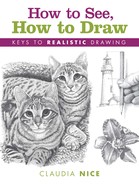Introduction
DEVELOPING YOUR DRAWING SKILLS THROUGH OBSERVATION
Although there may be some artists who do not work up to their potential, possibly due to fear of moving out of their comfort zone, I hesitate to label anyone's artwork good or bad. A drawing or painting is merely a reflection of how advanced a person is in his or her skills of observation and brain-to-hand interpretation. Some artists strive for a sense of mood or feeling rather than an accurate representation of the subject, even though they have developed observational skills. This is a choice of style and is not necessarily bad art.
This book is for those who wish to develop their representational drawing skills. Just as young children learn to create the alphabet letters, l believe that drawing skills can be taught and improved upon through practice. It's true that not all children go on to develop legible handwriting. Some become careless, content with whatever flows from their hand. Others just say “I can't do better,” when their early handwriting was just fine. Then there are those who would rather interpret the alphabet letters in their own manner — the abstract hand writers. Adults who have beautiful handwriting are not born with it; they develop it and maintain it with practice and discipline. So it is with drawing skills.
The first step is to develop a proper attitude. Saying “I can't” is the same as saying “I'm not willing to try.” An “I can't” attitude allows one to remain safely stagnant. You, who are exploring the pages of this book, are entertaining the idea that your work can be improved upon, and that is a very good way to start.
Step two is to banish the childish symbols and preconceived ideas from your work. They interfere with your ability to see and interpret your subject in a realistic manner. Preconceived notions of how a subject is supposed to look are always in our minds and will pop into our drawings when we are overwhelmed or confused with what we are “seeing” in our subject. Chapter Two will help you understand and get past your preconceived ideas.
Step three is learning the skill of observation. Not only will this improve your drawings, but you will begin to see the world around you in a richer, more detailed manner. Colors and contrasts will be more vivid. Shapes will be more apparent, and textures will touch your senses before you make contact with them. Observation is fundamental to the creation of accurate drawings — and learning better ways to observe the subject is what this book is all about.
The last step in developing your drawing skills is up to you: Practice, practice, practice!
